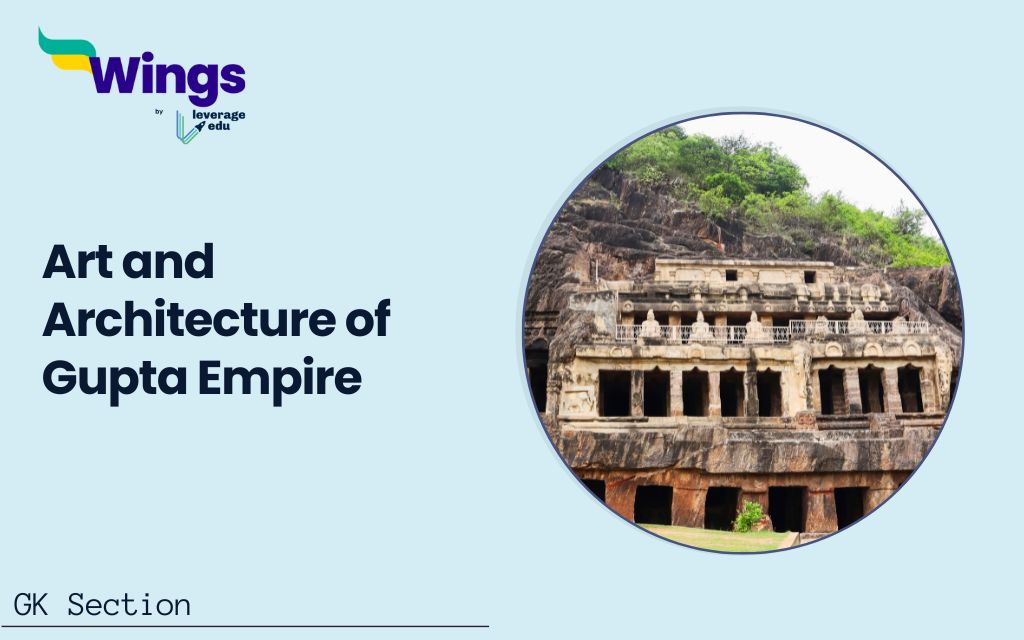The Gupta empire ruled over a large part of the Indian subcontinent between 319 to 467 CE. This era is also known as the ‘Golden Period’ due to its immense advancements in philosophy, science, and art. This blog will study the beauty of the Gupta Empire’s art and architecture, allowing students to learn about their history’s art and culture. This will also help students to prepare for exams such as UPSC, in which art and culture have a significant portion.
Contents
About Gupta Empire
Sri Gupta founded the Gupta Empire, which was further expanded by his successor, Chandragupta I.Additional details regarding gupta empire are:
- Chandragupta I is regarded as the real founder of the Gupta empire because of the contributions he made to the development of the Dynasty
- This empire was Magadha‘s seventh ruling dynasty, and it saw a rise in several fields throughout its time.
- Trade and commerce flourished throughout this time.
- The Gupta empire became well-known for its educational institutions, including Nalanda and Takshashila, which attracted academics from all around Asia.
- The great mathematician Aryabhaata also belonged to this time period and contributed to the development of many great concepts like zero and pie.
- The Gupta period saw advances in medicine, with texts such as the Sushruta Samhita and Charaka Samhita.
Also Read: Gupta Empire: Rise, Rulers, UPSC Notes

Art of the Gupta Empire
The art of the Gupta period is known for its elegance, grace, and idealised beauty. This time produced some of the finest sculptures and paintings, which frequently depicted religious themes.
- Buddhist Sculpture: The Gupta period is well known for its beautiful Buddhist sculptures. One of the finest examples of such sculpture is the Sarnath Buddha, which is renowned for its smooth, polished surface and calm appearance.
- Hindu Deities: Sculptures depicting Hindu gods and goddesses like Vishnu, Shiva, and Durga became more refined and detailed during this time period.
- Terracotta Art: Terracotta art was very popular at that period. Many objects displaying this art had religious themes and mythological stories.
- Ajanta Caves: The art of the Ajanta Caves is a prominent example of Gupta art. These paintings are well recognised for their precise design, vibrant colours, and expressive idols. These showed scenes from Buddha’s life and the Jataka stories. These paintings demonstrate excellent techniques in perspective, shading, and composition.

Architecture of the Gupta Empire
The architecture of the Gupta era was distinguished by its distinctive elements and patterns. This period saw the shift from rock-cut to structured temples. The temples constructed during this time are famous for their intricate carvings, patterns, and symmetry.
- Structure Temples: The Gupta dynasty saw an increase in structure temples made of stone and brick.
- Gupta Temples: The Dashavatara Temple in Deogarh and the Vishnu Temple in Tigawa are two excellent examples of Gupta temples. These temples have flat roofs and intricate carvings.
- Design: Gupta temples feature a simple design and layout, consisting of a square garbhagriha, mandapa, and ardhamandapa.
- Udayagiri Caves: These rock-cut caves in Vidisha are known for their sculptures and inscriptions. These were created during the Gupta dynasty and include both Hindu and Jain monuments.
- Ellora Caves: While the Ajanta Caves are best known for their paintings, the Ellora Caves also feature rock-cut temples and monasteries from the Gupta period, which showcase beautiful work and patterns.
Features of Art and Architecture of the Gupta Empire
The art and architecture of this era are rich in symbolic meaning.
- It reflects current religious and philosophical beliefs, such as the lotus flower pattern, which represents purity and spiritual enlightenment.
- Figures created at that time were frequently shown with slender, elongated bodies, delicate smiles, and elaborate jewellery and clothing.
- The use of precise mathematical proportions and symmetry in the design of temples and sculptures results in a balanced appearance in Gupta art and architecture.
- The art and paintings of the Gupta period are detailed and realistic.
Also Read: Samudragupta – The Indian Napolean
Legacy and Influence in the Contemporary Era
The Gupta Empire’s art and architecture had a profound impact on modern-day Indian art and architecture. The refined styles, iconography, and techniques established during this period had an impact on later Indian temple building and sculpture. The Gupta period witnessed the heights of Indian art and architecture. It established standards that have inspired artists and architects for ages.
In summary, the Gupta Empire made important contributions to Indian art and architecture. It was a combination of beauty, religious symbolism, and technological creativity. This period’s influence will live on in history books because of its artistic achievements and importance in shaping India’s cultural heritage.
FAQs
While Sri Gupta was the first ruler of the Gupta line Chandragupta I is considered as being the real founder of the Gupta Dynasty because of his significant contribution to the growth and development of the Gupta Dynasty.
Some of the notable art of the Gupta empire were the head of Shiva, the standing Buddha in Saranath, The red sandstone image of the Buddha located in Mathura, Terracotta art, paintings of Ajanta Caves, etc.
Art is a human activity that involves creativity and the natural expression of one’s imagination. It can take many forms, including visual art, performance art, literary arts, and applied arts. Architecture is the art and science of designing and building physical structures. It mixes aesthetics with practicality, which is affected by cultural or societal factors.
This was all about the “Art and Architecture of Gupta Empire”. For more such informative blogs, check out our UPSCExams Section and Study Material Section, or you can learn more about us by visiting our Indian exams page.
 One app for all your study abroad needs
One app for all your study abroad needs














